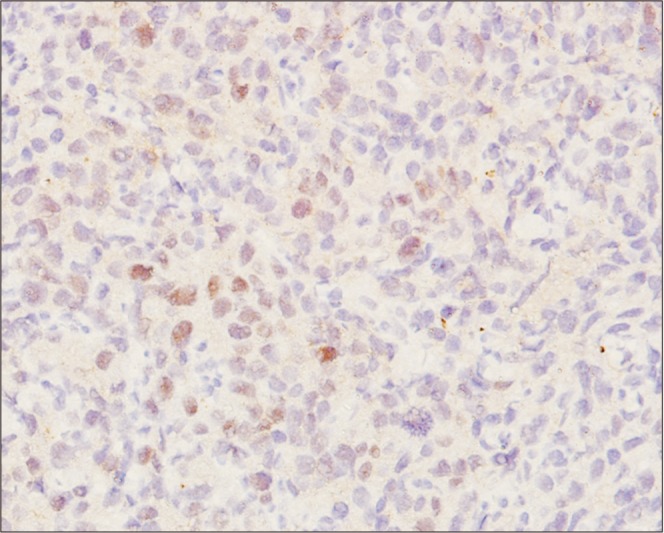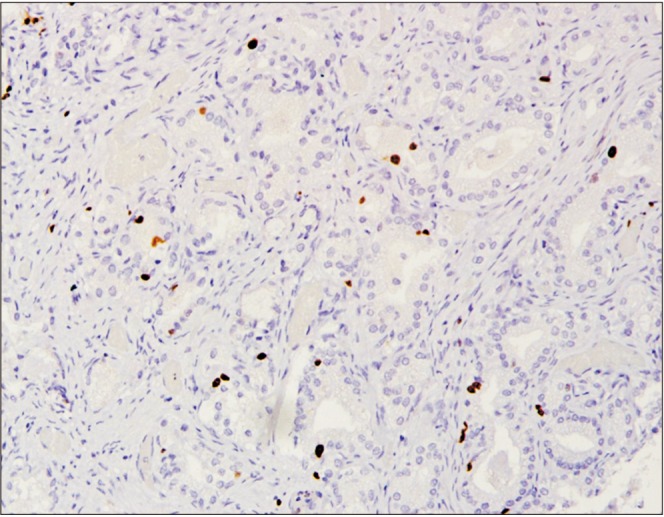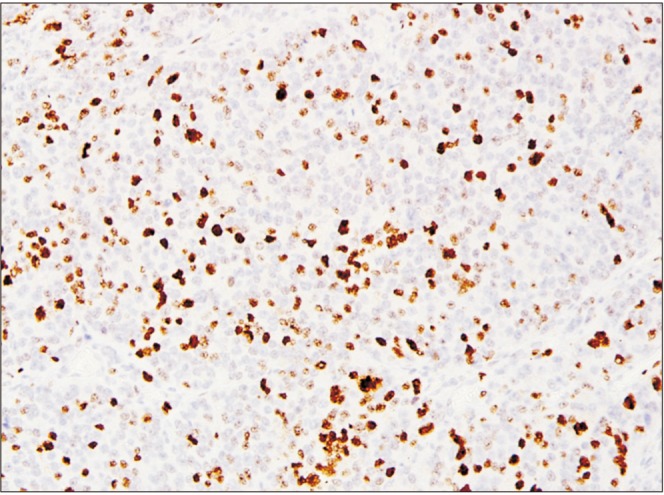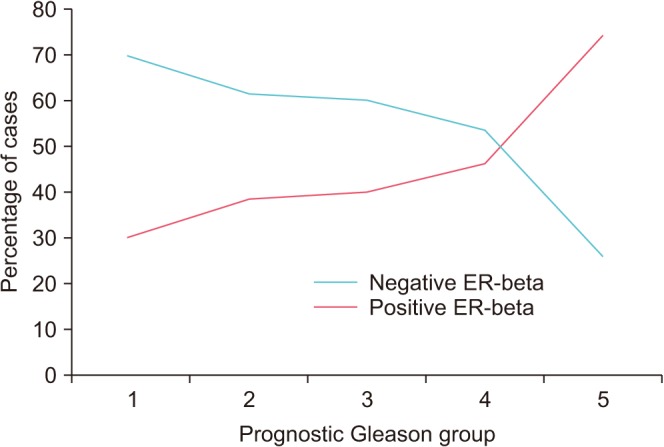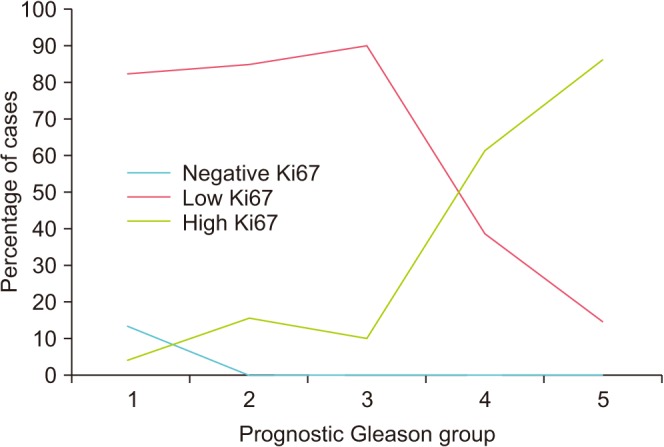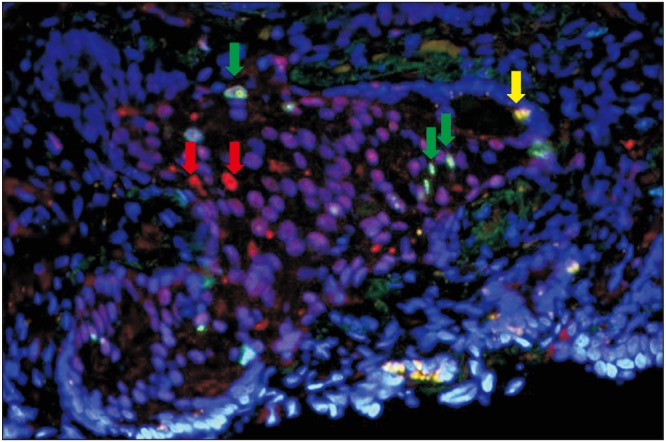Investig Clin Urol.
2018 Jul;59(4):232-237. 10.4111/icu.2018.59.4.232.
Role of co-expression of estrogen receptor beta and Ki67 in prostate adenocarcinoma
- Affiliations
-
- 1Department of Pathobiology and Medical Diagnostic, Faculty of Medicine and Health Sciences, Universiti Malaysia Sabah, Sabah, Malaysia. nazirah@ums.edu.my
- 2Department of Surgery, Faculty of Medicine and Health Sciences, Universiti Malaysia Sabah, Sabah, Malaysia.
- 3Department of Pathology, Faculty of Medicine, Universiti Kebangsaan Malaysia, Kuala Lumpur, Malaysia.
- KMID: 2414755
- DOI: http://doi.org/10.4111/icu.2018.59.4.232
Abstract
- PURPOSE
To evaluate the expression of estrogen receptor (ER)-beta and Ki67 in prostate cancer and study their relationship.
MATERIALS AND METHODS
We analyzed 101 cases of prostate adenocarcinoma diagnosed from January 2011 to June 2015 in 100 patients. Immunohistochemical staining of ER-beta and Ki67 was analyzed according to Gleason score categorized into prognostic groups of 1 to 5. Double-immunofluorescent staining of ER-beta and Ki67 was performed in a total of 20 cases to study the co-expression and the relationship between these markers within the same tumor.
RESULTS
A total of 53 of 101 cases (52.5%) were positive for ER-beta expression. There was a positive correlation whereby a high percentage of ER-beta expression was seen in the higher prognostic groups (groups 4 and 5; p=0.007). High Ki67 expression was observed in the higher prognostic group, whereas low Ki67 or negative expression was found in the lower prognostic group (p<0.001). The majority of cases evaluated with double-immunofluorescent staining (14/20) showed co-expression of ER-beta and Ki67 at the individual cell level.
CONCLUSIONS
ER-beta and Ki67 are independent tumor markers in high prognostic groups. Hence, co-expression of ER-beta and Ki67 indicates a more aggressive tumor with a poorer prognosis.
MeSH Terms
Figure
Reference
-
1. Wong MC, Goggins WB, Wang HH, Fung FD, Leung C, Wong SY, et al. Global incidence and mortality for prostate cancer: analysis of temporal patterns and trends in 36 countries. Eur Urol. 2016; 70:862–874. PMID: 27289567.
Article2. Ministry of Health. Summary of Malaysian national cancer registry report 2007–2011. Putrajaya: Ministry of Health;2017. 1. p. 19.3. Hartman J, Ström A, Gustafsson JÅ. Current concepts and significance of estrogen receptor β in prostate cancer. Steroids. 2012; 77:1262–1266. PMID: 22824289.
Article4. Imamov O, Morani A, Shim GJ, Omoto Y, Thulin-Andersson C, Warner M, et al. Estrogen receptor beta regulates epithelial cellular differentiation in the mouse ventral prostate. Proc Natl Acad Sci U S A. 2004; 101:9375–9380. PMID: 15187231.5. Asgari M, Morakabati A. Estrogen receptor beta expression in prostate adenocarcinoma. Diagn Pathol. 2011; 6:61. PMID: 21733187.
Article6. Horvath LG, Henshall SM, Lee CS, Head DR, Quinn DI, Makela S, et al. Frequent loss of estrogen receptor-beta expression in prostate cancer. Cancer Res. 2001; 61:5331–5335. PMID: 11454669.7. Dunsmuir WD, Gillett CE, Meyer LC, Young MP, Corbishley C, Eeles RA, et al. Molecular markers for predicting prostate cancer stage and survival. BJU Int. 2000; 86:869–878. PMID: 11069416.
Article8. Christoforou P, Christopoulos PF, Koutsilieris M. The role of estrogen receptor β in prostate cancer. Mol Med. 2014; 20:427–434. PMID: 25032955.
Article9. Al-Maghrabi JA, Hassan TM, Abdel-Meguid TA, Mosli HA. Expression of estrogen alpha and beta receptors in prostate cancer and hyperplasia: immunohistochemical analysis. Afr J Urol. 2010; 16:79–87.
Article10. Muñoz E, Gómez F, Paz JI, Casado I, Silva JM, Corcuera MT, et al. Ki-67 immunolabeling in pre-malignant lesions and carcinoma of the prostate. Histological correlation and prognostic evaluation. Eur J Histochem. 2003; 47:123–128. PMID: 12777207.
Article11. Cowen D, Troncoso P, Khoo VS, Zagars GK, von Eschenbach AC, Meistrich ML, et al. Ki-67 staining is an independent correlate of biochemical failure in prostate cancer treated with radiotherapy. Clin Cancer Res. 2002; 8:1148–1154. PMID: 12006531.12. Sulik M, Maruszak K, Puchalska J, Misiukiewicz-Poć M. Expression of Ki-67 as a proliferation marker in prostate cancer. Pol Ann Med. 2011; 18:12–19.
Article13. Torlakovic E, Lilleby W, Torlakovic G, Fosså SD, Chibbar R. Prostate carcinoma expression of estrogen receptor-beta as detected by PPG5/10 antibody has positive association with primary Gleason grade and Gleason score. Hum Pathol. 2002; 33:646–651. PMID: 12152165.14. Royuela M, de Miguel MP, Bethencourt FR, Sánchez-Chapado M, Fraile B, Arenas MI, et al. Estrogen receptors alpha and beta in the normal, hyperplastic and carcinomatous human prostate. J Endocrinol. 2001; 168:447–454. PMID: 11241176.
Article15. Fixemer T, Remberger K, Bonkhoff H. Differential expression of the estrogen receptor beta (ERbeta) in human prostate tissue, premalignant changes, and in primary, metastatic, and recurrent prostatic adenocarcinoma. Prostate. 2003; 54:79–87. PMID: 12497580.
- Full Text Links
- Actions
-
Cited
- CITED
-
- Close
- Share
- Similar articles
-
- Estrogen and Progesterone Receptor Expressions in Benign Prostatic Hypertrophy and Prostatic Adenocarcinoma
- An Immunocytochemical Study Of Estrogen Receptor In The Prostate
- Role of Estrogen Receptor-alpha in the Regulation of Claudin-6 Expression in Breast Cancer Cells
- Cyclin E expression in benign and malignant epithelial neoplasms of the gallbladder
- Comparison of estrogen receptor beta expression between breast cancer and normal mammary tissue and relationship with clinicopathological factors

